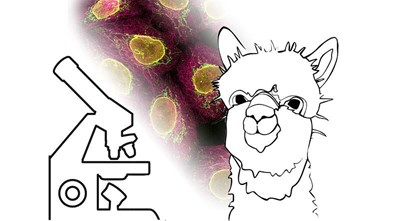The importance of blocking when using Nano-Secondary reagents for IF
Blocking improves the sensitivity by reducing nonspecific background and therefore increases microscopy image quality. Insufficient blocking results in higher background noise.
Introduction
Blocking is an essential step during the preparation of a sample for immunofluorescence detection. Blocking improves the sensitivity by reducing nonspecific background and therefore increases image quality. Insufficient blocking results in higher background noise and over-blocking can even mask the specific signal.
The aim of blocking is to prevent non-specific interactions of the primary and secondary antibody by covering reactive sites of the sample. In theory any protein that does not bind to the target antigen can be used as blocking reagent. In fact, sera blocking solutions and protein blocking buffers are commonly used.
Blocking with serum
Serum contains a lot of proteins, which block non-specific epitopes in the sample. In addition, sera carry antibodies that will bind to Fc receptors of the sample tissue and prevent primary and secondary antibodies from doing the same.
Generally, serum from the source species of the secondary antibody is used for blocking. If the blocking solution originates from the species in which the primary antibody was raised, the secondary antibody will label both the anti-target primaries as well as the blocking primaries and the specificity will be lost.
Example: if you use a primary antibody from mouse and your secondary antibody was produced in goat, goat serum would be most suitable for blocking.
Blocking with proteins
Protein blocking solutions consist of highly concentrated proteins like BSA, Casein or skimmed milk / nonfat dry milk in buffer. The proteins will outcompete for the non-specific binding to the sample with the primary and secondary antibodies.
Blocking with proteins is an inexpensive method. Additionally, protein blocking works well when secondaries from different species are used for immunofluorescence multiplexing.
Blocking recommendation for immunostaining with Nano-Secondary reagents
Nano-Secondary reagents are single domain antibodies. They are originally generated from immunization of alpacas, they are carefully selected for high specificity to the primary antibody target molecule recombinantly produced and purified. Therefore, Nano-Secondary reagents have a very low background.
Since Nano-Secondary reagents lack the Fc part of a conventional antibody, blocking with alpaca or llama serum to minimize binding to Fc receptors is not required. Standard protein blocking solution e.g. 4% BSA or skimmed milk in PBS is sufficient when using Nano-Secondary reagents for immunostaining.
Blocking protocols
Although many labs follow established blocking protocols and blocking buffers, blocking should be optimized for each experiment. No single blocking solution works best for all samples, and empirical testing is critical to obtain the best possible results for a given combination of specific antibodies and sample composition.
See App Note “Blocking in immunofluorescence” for detailed blocking protocol.
Related Content
Why are recombinant Nanobodies/ VHHs beneficial?
Advantages of recombinant Nano-Secondary reagents
Important facts to know when using Nano-Secondary reagents
How to choose the best secondary antibody for your application
Want to upgrade your immunofluorescence workflow? Go Direct!

Support
Newsletter Signup
Stay up-to-date with our latest news and events. New to Proteintech? Get 10% off your first order when you sign up.

